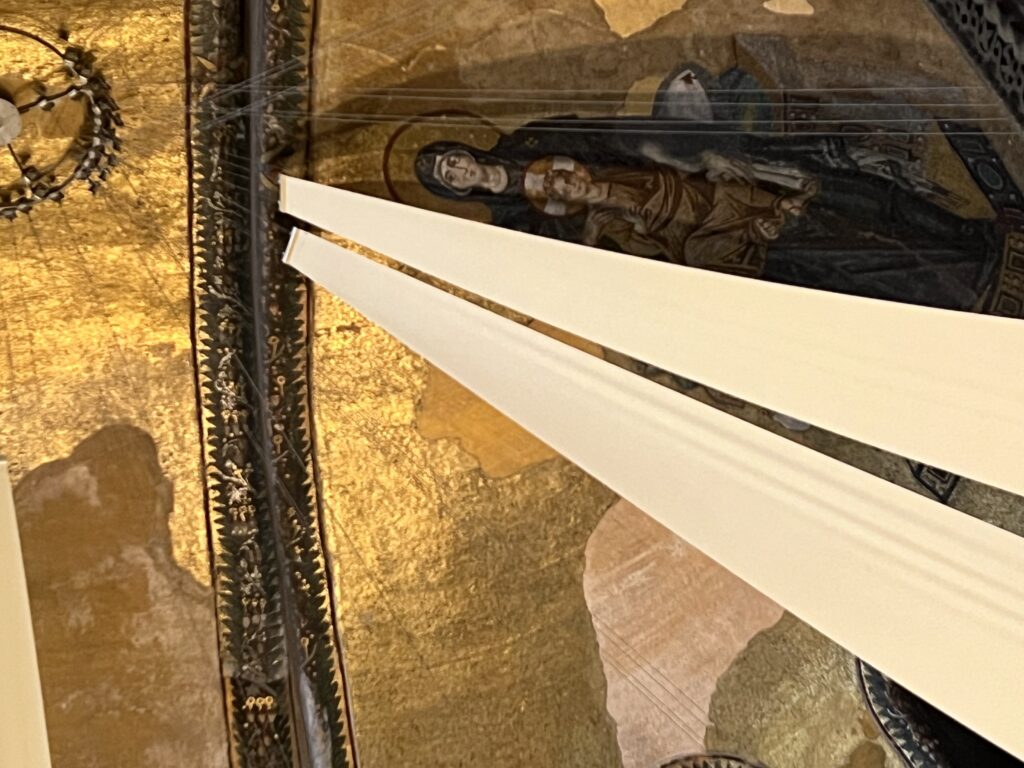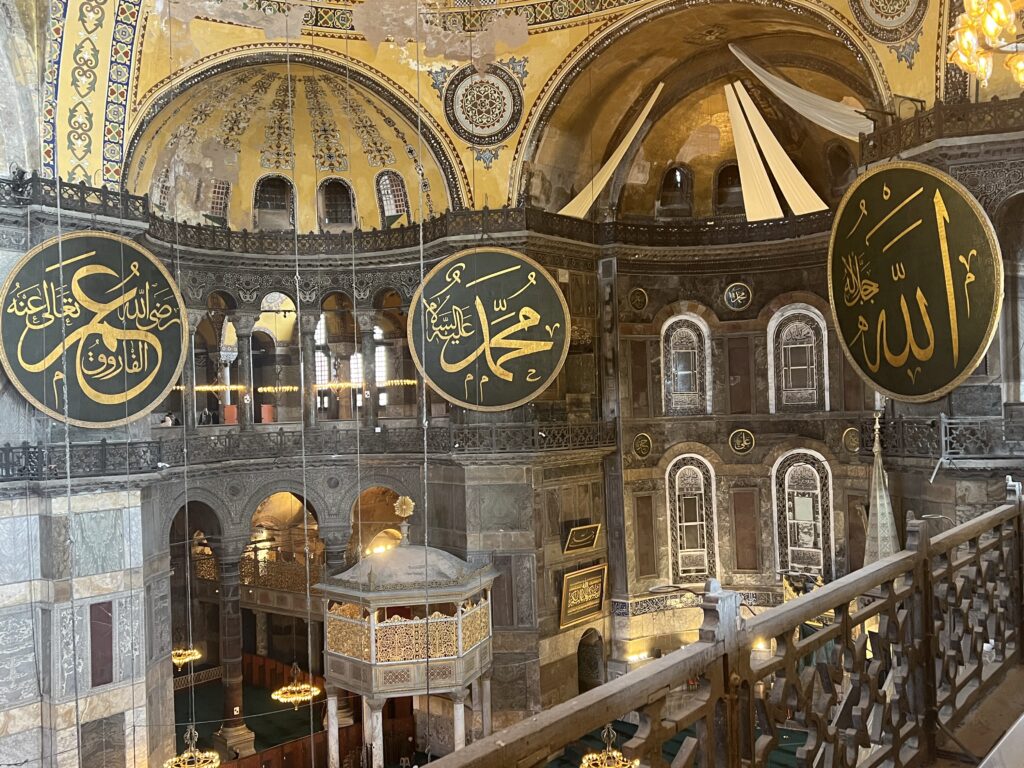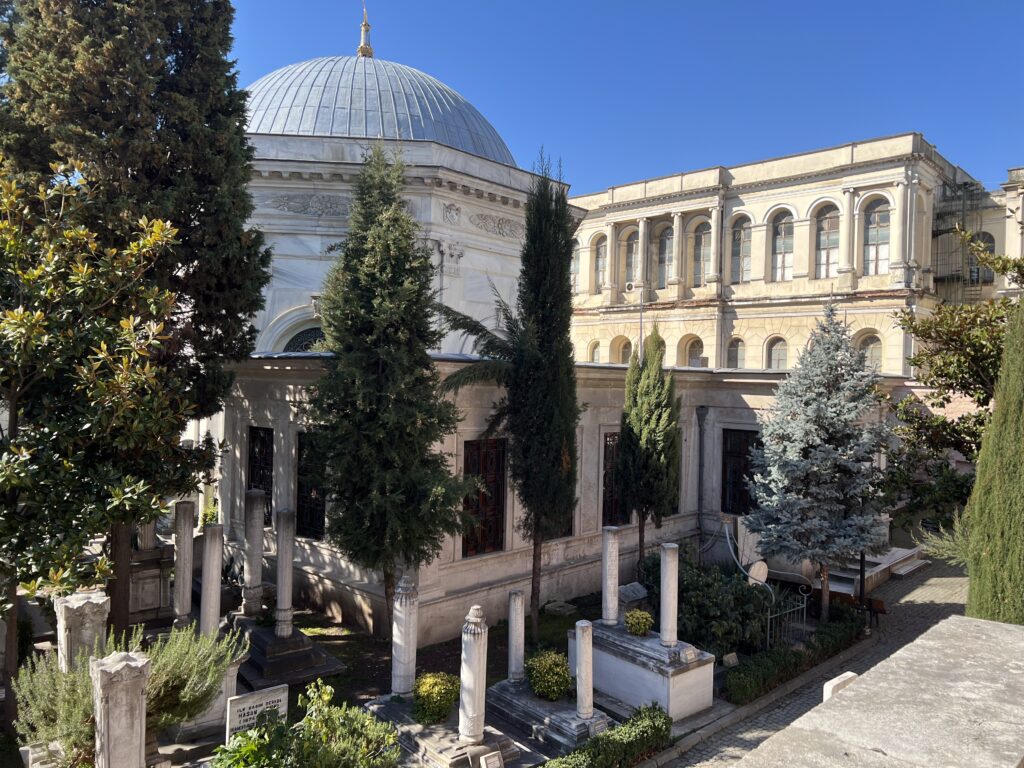Asif M Basit, Ahmadiyya Archive & Research Centre

If a friend calls you and asks: “I’m in a city where everywhere I look, I see multiple mosque domes and minarets. Guess where I am?” You should immediately know that your friend is calling you from Istanbul.
This is the sight that greets your eyes when you arrive at Istanbul and exit the airport. Whichever direction you look, you’ll see multiple mosques with distinctive domes and pointed minarets. Some near, some far. You’ll ask the taxi driver about each mosque: “Is this the Blue Mosque?” And each time he’ll smile, as if amused by your innocence, and reply: “No, no. This is certainly not the Blue Mosque. That one is much larger.” And your eagerness to see this mosque will only grow; if this mosque isn’t large, how magnificent must the truly large one be?
Then you’ll travel through the streets, cross bridges, and reach your accommodation at a hotel. The Blue Mosque might not usually be visible, for it is located in the old part of Istanbul – the original Istanbul; in the area which was once Constantinople, the prized capital of the Roman Empire, which contracted eastward to become the Byzantine Empire.
So this realisation takes the newcomer to Istanbul into strange feelings – that they are in a city which was once the apple of the world’s eye. Rather, a star in the sky of civilisation, culture, industry and craftsmanship. A star that many tried to pluck from the sky and bring within their grasp, but failed. Then Islam emerged, along with the heavenly news of “the victory of Rome.” And Muslims began to cherish this dream.
For eight centuries, Muslims lived with the aspiration to conquer Constantinople, the Roman Empire. The Islamic empire, through various phases, launched multiple campaigns for this purpose, but only to always fail. Finally, in 1453, the Ottoman Sultan Mehmed II conquered Constantinople. Thus, this star in the Muslim eye was brought into the lap of a Muslim empire, making the Ottoman Empire the apple of Muslims’ eyes.
Ottoman sultans began using the title of caliph later, but perhaps this was the moment, upon fulfilling the Prophet’ssa prophecy, when the dream of donning the mantle of caliphate was first envisioned. The prophecy stated that whoever conquered Constantinople would not be an ordinary commander, but a glorious one. However, we won’t delve into the actual reality of this prophecy and the interpretations of “the victory of Rome” here.
For now, we are in Istanbul, and we’ll feel the cultural and civilizational spirit pulsating in this city’s body. In 1517, when Sultan Selim I conquered the Mamluk-controlled Egypt and erased the remnants of the Abbasid caliphate to establish Ottoman rule over Mecca and Medina, he felt justified in claiming the crown of caliphate for himself and his successors.
It’s not as if the rest of the Muslim world accepted the Ottomans as their caliphs, as every other king in the Muslim world was dreaming of being seen as such. But then the Ottomans were fierce warriors, too. They continued expanding their dominion, and thus the Ottoman Empire emerged as a magnificent empire. Eventually, no other claimant to the caliphate remained, for who else could produce such an empire? The concept of caliphate had been tied to the notion of empire so emphatically that empire and state had become the proof of a caliph’s legitimacy. On top of that, what other Muslim king was also the governor of the Haramain – the two holy sanctuaries of Mecca and Medina?
Every Muslim who travelled from anywhere in the world to perform Hajj or Umrah in the Haramain entered by the grace of the Ottoman Empire. This distinction gave the Ottoman Empire a prestige that no other Muslim government possessed.
When Constantinople was conquered from the Romans, Sultan Mehmed, who was thus called Mehmed the Conqueror, entered the heart of this empire – the majestic cathedral known as Hagia Sophia. This was his real celebration of victory, that the church, which was the standard-bearer of Roman (and Christian) imperial glory, was now under Muslim control. This cathedral was immediately converted into a mosque.
From here, this warrior nation began to present and bolster its Islamic identity. Ottoman sultans built mosques everywhere. A decree was issued to build one mosque for every thousand people in Istanbul. Each sultan built a special mosque that was attributed to him and named after him.
How deeply the conquest of Hagia Sophia impressed the hearts and minds of Ottoman sultans is evident from the architectural style of mosques in Istanbul: a large semicircular dome with smaller domes surrounding it. Since something had to be done to fashion Hagia Sophia as a mosque, minarets were erected around it. Thus, every mosque built during the Ottoman era, besides having domes, was identified by minarets that were similar to those of Hagia Sophia, pointed and tall.

Those days are long gone when people would travel to a country and then depict its famous sites and attractions in travelogues. They would share facts like a certain minaret is so many meters tall and a dome’s diameter is so much. But now, even if you visit these places and try to share such facts in a gathering of family and friends, your audience will tell you things you didn’t know. In fact, you probably wouldn’t have seen these places from the angles that some young person in your audience will immediately show you in 4K quality on their phone. And instead of you, who returned from travel, being the centre of attention, everyone will gather around that young person’s phone while you sit aside silently sipping on your tea (in embarrassment).
So why should we invite such humiliation by stating such facts? Yes, feelings are personal, so let’s just talk about them.
This is the scenery – a landscape filled with mosques, or rather, the background of the scenery. Because against this background, the game of life going on in Istanbul is completely Western. Lifestyle, clothing and social trends all follow Western patterns. It is not for nothing that the European Union has embraced Turkey.
So Istanbul’s landscape is formed by countless mosques in the background and Western civilisation at play in the foreground. But just as when you focus on something with a camera lens, the rest of the things become relatively blurry, similarly, when walking through the ancient, beautiful cobbled streets of Istanbul’s old city (which was once Constantinople), the foreground comes into focus and the background becomes somewhat blurred.
But if you belong to a community whose backbone is Khilafat, and you are aware of the importance of caliphate, then your focus automatically stays fixed on Istanbul’s background. The glitter of Western civilisation, tourists’ colourful outfits, their laughter and excitement, all will recede into the background, and the history of this city connected to a so-called caliphate will stand right before your eyes: the history of the Ottoman Empire. Its rise. Its fall. The causes of that fall. Everything. But this is just a brief column, not a research article, so we won’t go deep into all of that.
And if you’ve come to Istanbul specifically to study Ottoman Empire documents, and you sit with your head in these old, mouldy papers from morning until afternoon, then from afternoon until night, you become unable to see any other colour of Istanbul. The city’s history weighs on your heart and mind, and even while being a tourist yourself, and with tourists all around, you slip into some other world.
What was there to look for in historical documents, and what was found is a story for another time, which will soon reach you through the pages of Al Hakam. Here is just a very brief account of those afternoons spent outside the official records in the old city of Istanbul.
The first day, I left the Ottoman Archives and took a taxi to my hotel. After resting for a while, I reached Sultanahmet, the central square of the old city, just a few steps from the hotel. This is where Hagia Sophia and the Blue Mosque stood tall, and flocks of tourists stood overawed at any given time of the day or night. But if your mind is caught up in the city’s magnificent history, then above the heads of this crowd, you find a strange feeling spread like a layer of mist above a field of crops.
The voices of tourists talking and chattering remain below, and your imagination takes off and transcends through the misty layer; emerging from it is where you see traces of the cathedral in this mosque called Hagia Sophia.
Inside, the names of Allah, Muhammadsa, and the four Rightly Guided Caliphs are displayed in calligraphy on huge boards – an attempt to give the building the character of a mosque. The carpet has patterns of Islamic art for the same reason. And then you notice something strange – large, white sheets stretched in certain places in the dome.

Humans are curious by nature anyway, and if you are a tourist, this curiosity increases even more; and if, as a tourist, you happen to have paid for entry, you consider this curiosity your right. You want to see behind these sheets out of this justified curiosity, and by changing your angle, you can see what is trying to be concealed behind the asymmetrically stretched sheets in the dome of Hagia Sophia.
What you see are images of Jesus, son of Mary, and Mary, mother of Jesus, which Roman artists had engraved in the domes of Hagia Sophia. This church is approximately as old as the Holy Prophetsa, a few years older even, because it was built between 532 and 537 CE.
This was the heyday of the Byzantine Empire. They left a trophy wherever they went, mostly in the form of majestic churches or some other form of breathtaking architecture. Byzantine emperors stood as flagbearers of Christianity, ruling through divine right, and wherever they went, a magnificent church was the first mark they would erect in every land they ruled. The Aksumite Empire, or Abyssinia, was also a Christian empire that ran under the patronage of the Byzantine Empire.
When the southern Arabian region, present-day Yemen, came under Aksumite control, the viceroy of the Aksumite emperor, Abraha, established there a large cathedral. But since the Ka‘bah in Mecca remained the centre of pilgrimage, Abraha planned to demolish the Ka‘bah and establish the supremacy of his church. This happened around the same time when Hagia Sophia came into existence – about forty years later, in 570. How that attack failed, we won’t go into detail here.
We’ll just mention that while a great church like Hagia Sophia was coming into existence on one side of Arabia, the great church of Sana’a was being established in the south of the Arabian Peninsula. And in the same era, Prophet Muhammadsa was born – as poison spread, God also sent the antidote.
The Blue Mosque is located directly opposite the Hagia Sophia. Its real name is Sultanahmet Mosque, named as the namesake of the Ottoman Sultan Ahmed II. This mosque didn’t appear blue during the day or at night. Rather, as night fell on the city, the mosque was illuminated with a flood of red light from all around. It was only upon entering that I realised all the decorations inside were turquoise in colour, which, in English, is called “turquoise,” meaning Turkish blue.
Whether you travel in the clouds of history above the crowd of tourists, the crowd of tourists always wins and dominates the scene. I wanted to detach myself from these tourist attractions. Those times are also gone when photographers would roam such places and take your picture outside these locations to sell to you. Now, every hand has a camera and every person is a photographer. So in this mosque, hands raised in prayer might not stand out as much as those stretched out for securing been-there-done-it selfies.
I too quickly took a selfie or two, but my real destination was the tomb of Sultan Abdul Hamid II – that same Sultan Abdul Hamid during whose reign the legs of the Ottoman Empire’s throne were trembling. Western influence had gained strength, and a wave of awakening was taking Turkey in its fold. The movements against monarchical systems in Europe had also touched young and progressive minds in Turkey and were gaining momentum. They also declared aversion to monarchy, even if it was in the name of an Islamic caliphate.
Just as the West declared aversion to Christianity to eliminate monarchy, Turkey’s new generation too was ready to abandon monarchy, even at the cost of Islam.
Sultan Abdul Hamid II sent his agents to the Muslim world to mobilise Muslims in favour of the Ottoman Empire, in the name of saving the only Islamic caliphate. These agents went to various Muslim countries and cities and became busy in this effort.
One such agent, named Husseyn Kami, a confidante of the sultan, was active in the northern regions of India. He would meet influential Muslim leaders and encourage them to ally with the Ottoman caliphate. During this journey, he also reached Qadian and met the founder of the Ahmadiyya Community, Hazrat Mirza Ghulam Ahmadas of Qadian.
In this meeting, the Promised Messiahas clearly told him that he and his community were believers in the heavenly kingdom. And forming worldly alliances with any king was not in the nature of this community. He also told him that the days of the Ottoman Empire were over. Go and tell your sultan!
Husseyn Kami, unsuccessful and disappointed, went to Karachi, where he was posted at the Ottoman consulate and wrote a report to the sultan.
I wanted to visit Abdul Hamid II’s mausoleum because, through him, a sign was manifested. After that, the Ottoman Empire never recovered, and the people of his own country virtually deposed Sultan Abdul Hamid II. The sultans who came after him were symbolic kings and caliphs in name only. And then, eventually, the story of the Ottoman caliphate came to its end forever.

When this story was about to end, the founder of the community was no longer present as he had passed away in 1908. His son and caliph, Hazrat Mirza Bashir-ud-Din Mahmud Ahmadra, then head of the Ahmadiyya community, was committed to the welfare of the Muslim ummah. He advised the Muslim world that while Ahmadis also wished to save the Ottoman Empire for being a Muslim empire, movements launched in the name of a caliphate would not be effective because this was not the caliphate of the Holy Prophetsa of Islam. He further advised that if movements to save this worldly empire run in the name of the Prophet’ssa caliphate, they will certainly fail.
Time proved that this is exactly what happened. But these prophecies mentioned above were actually prophecies stated by the Holy Prophetsa. Constantinople was to be conquered by Muslims. However, the Ottoman conquest of it was not to be the final conquest promised; that part of the prophecy is yet to be fulfilled.
Then, regarding his own caliphate, the Holy Prophetsa prophesied that caliphate on the method of prophethood would remain for some time; then it would transform into kingship; then there would be cruel monarchies; then these eras too would pass. And then, he said, that caliphate on the pattern of prophethood would be established once again.
Thus, the last so-called caliphate of kingship and monarchy was the Ottoman Empire. With it ended the era of caliphates associated with state and empire. Now was the time for the caliphate on the pattern of prophethood to be established.
The Ottoman Empire was in decline when the Ahmadiyya caliphate was established in 1908. The Ahmadiyya caliphate had no worldly state and no earthly empire. It only bore the torch of spirituality. Ahmadiyya caliphate rose with the claim that it stood for the original message of the early Meccan period of Islam – the message of the Holy Prophetsa of Islam. It claimed to be a revival of the final message of the Hajjatul-Wida – the Holy Prophet’ssa final message to the Muslim ummah before his death.
Ever since the fall of the Ottoman Empire, there has been no claimant to the office of caliphate but the Ahmadiyya, save one that appeared by way of violence and withered away in the same way within a period of three years.

